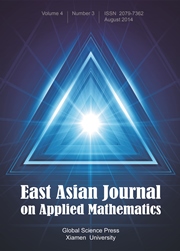Crossref Citations
This article has been cited by the following publications. This list is generated based on data provided by Crossref.
Adem, Khadijo Rashid
and
Khalique, Chaudry Masood
2014.
On the solutions and conservation laws of the coupled Drinfeld-Sokolov-Satsuma-Hirota system.
Boundary Value Problems,
Vol. 2014,
Issue. 1,
Muatjetjeja, Ben
and
Khalique, Chaudry
2014.
Benjamin–Bona–Mahony Equation with Variable Coefficients: Conservation Laws.
Symmetry,
Vol. 6,
Issue. 4,
p.
1026.
Mothibi, Dimpho
and
Khalique, Chaudry
2015.
Conservation Laws and Exact Solutions of a Generalized Zakharov–Kuznetsov Equation.
Symmetry,
Vol. 7,
Issue. 2,
p.
949.
Magalakwe, Gabriel
Muatjetjeja, Ben
and
Khalique, Chaudry Masood
2016.
Exact Solutions and Conservation Laws for a Generalized Double Combined sinh–cosh–Gordon Equation.
Mediterranean Journal of Mathematics,
Vol. 13,
Issue. 5,
p.
3221.
Motsepa, Tanki
Abudiab, Mufid
and
Khalique, Chaudry Masood
2017.
Solutions and conservation laws for a Kaup-Boussinesq system.
Vol. 1863,
Issue. ,
p.
280005.
Mogorosi, Tshepo E.
Freire, Igor L.
Muatjetjeja, Ben
and
Khalique, Chaudry Masood
2017.
Group analysis of a hyperbolic Lane–Emden system.
Applied Mathematics and Computation,
Vol. 292,
Issue. ,
p.
156.
Freire, Igor
and
Muatjetjeja, Ben
2018.
Symmetry analysis of a Lane-Emden-Klein-Gordon-Fock system with central symmetry.
Discrete & Continuous Dynamical Systems - S,
Vol. 11,
Issue. 4,
p.
667.
Motsepa, Tanki
and
Masood Khalique, Chaudry
2018.
On the conservation laws and solutions of a (2+1) dimensional KdV-mKdV equation of mathematical physics.
Open Physics,
Vol. 16,
Issue. 1,
p.
211.
Gao, Ben
and
Wang, Yanxia
2019.
Invariant Solutions and Nonlinear Self-Adjointness of the Two-Component Chaplygin Gas Equation.
Discrete Dynamics in Nature and Society,
Vol. 2019,
Issue. ,
p.
1.
Gao, Ben
and
Zhang, Yao
2019.
Symmetries and conservation laws of the Yao–Zeng two-component short-pulse equation.
Boundary Value Problems,
Vol. 2019,
Issue. 1,
Naz, Rehana
and
Torrisi, Mariano
2022.
The Transmission Dynamics of a Compartmental Epidemic Model for COVID-19 with the Asymptomatic Population via Closed-Form Solutions.
Vaccines,
Vol. 10,
Issue. 12,
p.
2162.


